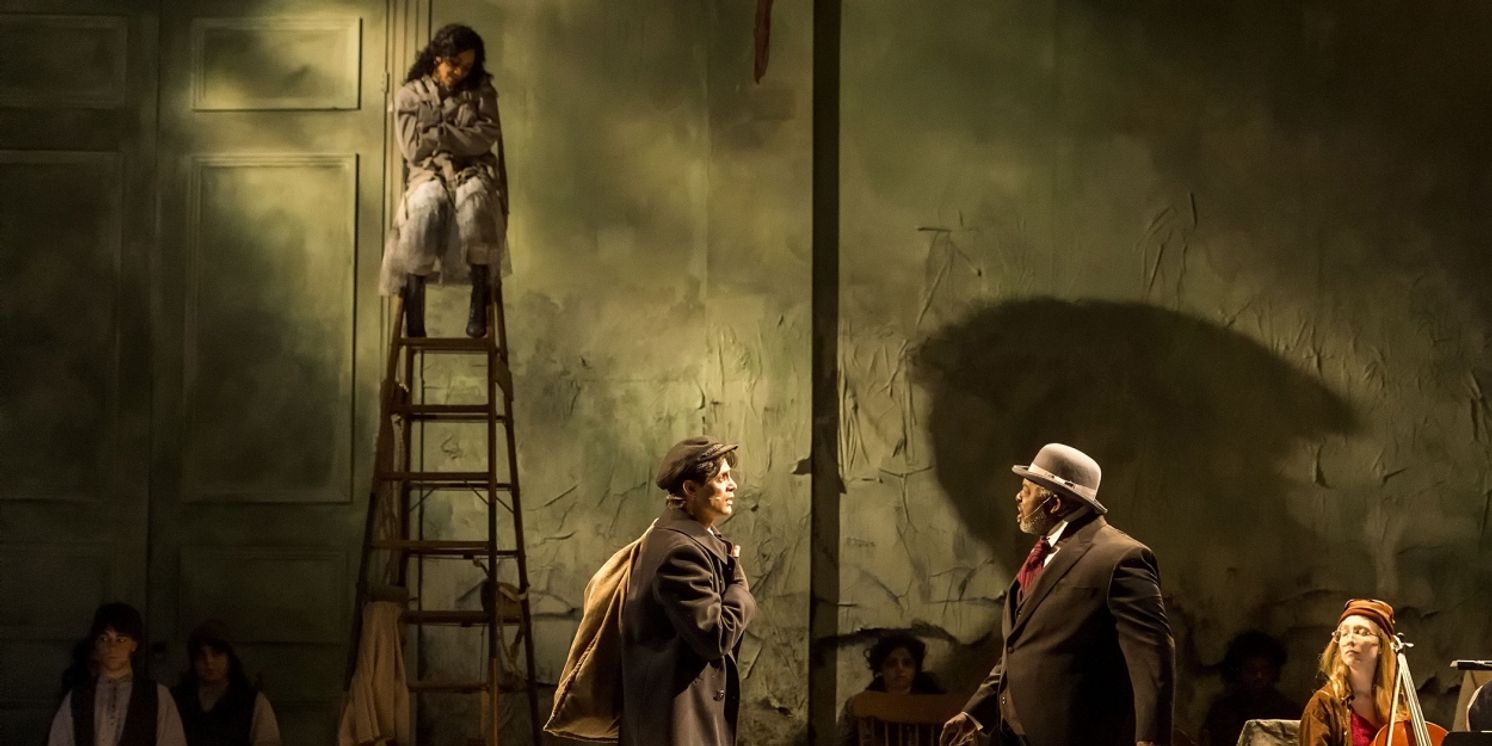Review: SWEENEY TODD at A Noise Within
A production which humanizes each character without sacrificing humor or horror

When the prologue begins, setting the scene for A Noise Within’s production of Sweeney Todd: The Demon Barber of Fleet Street, the chords which seem powerfully ominous coming from an organ land as effete when plunked out on an upright piano. Likewise, Hal Prince’s iconic original staging (immortalized on home video, thus imbuing itself onto nearly every production since) feels far distant from the warnings to “attend the tale” by an ensemble seated in chairs looking back at us. One might ask (as I did) if this production of Sweeney Todd, seemingly resting on the darkness of the material, is ever going to move, wrapping us up in the story and moving us.
Julia Rodriguez-Elliott’s reimagining owes little to Prince’s staging, but I imagine he would envy the mechanical sounds the ladders make as they are dragged about the stage, effectively conjuring images of Victorian slums. In classic ANW style, Rodriguez-Elliott has simplified everything, returning to the text and highlighting elements of the (mercifully and artfully) truncated libretto. Without a drop of stage blood, she has crafted lasting images of violence that grip us and carry the narrative. As with her recent production of Animal Farm, Rodriguez-Elliott is able to spin theatre magic from nothing, delineating space without major scenery changes. For ‘Greenfinch and Linnet Bird’, a bed and a small assortment of birdcages give more of a sense of the isolation and captivity of the ingenue, Johanna than a literal presentation of an enclosure ever could. Rather than sitting passively at her window, Rodriguez-Elliott has Johanna (played with an appropriately tender tremolo by Joanna A. Jones) manically sorting her collection of cages. Suddenly, without rewriting a word of text, Johanna has a more nuanced and human story, and we are immediately invested.
The reduced orchestrations, carried by a trio of musicians on stage, allow actors to lend a contemporary sense of humanity to the characters. Particularly Geoff Elliott who is curmudgeonly and somber in the titular role and Cassandra Marie Murphy, whose Mrs. Lovett feels refreshingly alive, take advantage of the freedoms afforded them by a small pit who can follow their whims. Elliott’s Todd is thus not a figure of melodrama, screaming his ‘Epiphany’ over a full strings section, but a father and husband unmoored by the cruel loss of his family. He is not a villain in a musical, but a man who has been mistreated by an unjust system. Murphy lends Mrs. Lovett a vocal adroitness and pop sensibility that make her songs surprisingly pleasant to the ear without overshadowing the gruesome, histrionic selfishness of the despicable character. From her first appearance bemoaning ‘The Worst Pies in London’, Murphy’s Lovett seems to be part Madame Defarge and part overgrown kindergartner, mashing up and spitting into a mound of crumbled pies in an act nearly as disturbing as her later cannibalistic ventures. Her strong passaggio makes the melancholic ‘Wait’ a memorable highlight of the first act.
Possibly the highest praise one can bestow on a production is that, without having first read the dramaturgical note by Dr. Miranda Johnson-Haddad, the intentions of the production landed as intended. As Johnson-Haddad expounds, “most of the central characters in Sweeney Todd appear to be suffering from some form of mental illness, which in today’s world we would understand as resulting from trauma.” The centering of the humanity of the characters drives the entire production. This is not to say that ANW has crafted an introspective, Actors’ Studio production devoid of humor and theatricality. In fact, the humanity afforded each character seems to make the story and rich score a bit more haunting. Sung around the piano, ‘A Little Priest’ has never been so delightfully vaudevillian, and the punchlines have never seemed so delightfully organic. Other highlights of the production include the crystalline soprano of Amber Liekhus’ Beggar Woman, a sumptuously deteriorated set designed by Francois-Pierre Couture, and delicious wigs by Tony Valdes. After all, what’s a musical about a barber without some gorgeous heads of hair?
Those new to the show are in for a treat with ANW’s staging, and familiar fans will be met with exciting interpretations that will keep them on their toes.
Reader Reviews

Videos

